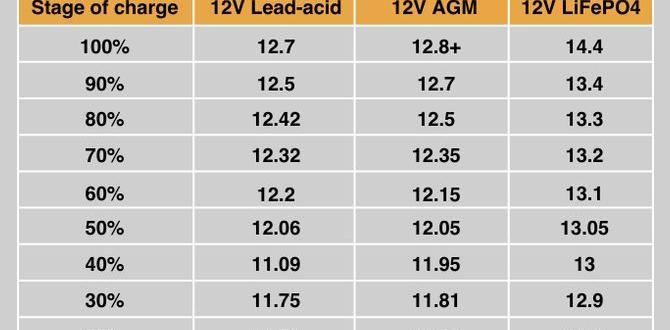Have you ever wondered, “What’s a good voltage for a car battery?” You’re not alone! Many people ask this question when learning about cars. Knowing the right voltage can help you keep your vehicle running smoothly.
Imagine driving down the road, and suddenly your car won’t start. Frustrating, right? Often, a battery issue is the cause. A good voltage for a car battery usually ranges between 12.6 to 12.8 volts. But why does this matter?
Here’s a fun fact: a healthy battery helps your car start in the cold and run all its electrical systems. If the voltage drops too low, you could be in trouble. By the end of this article, you’ll have a better idea of how to check your car’s battery voltage and what it means for your ride!
What’S A Good Voltage For A Car Battery: Essential Insights

What’s a Good Voltage for a Car Battery
A car battery usually needs to have around 12.6 to 12.8 volts when fully charged. But why does this matter? Well, if your car battery drops below 12.4 volts, it might struggle to start your engine. Imagine being late for school, and your car won’t start! Keeping an eye on your battery’s voltage can save you from that hassle. So, check your battery regularly to make sure it’s in good shape.Understanding Car Battery Voltage
Explanation of voltage and its importance in car batteries. Typical voltage range for healthy car batteries.Voltage is like the energy boost for your car battery. It keeps everything working smoothly, from your headlights to the radio blasting your favorite tunes. A healthy car battery usually sits at around 12.6 volts when fully charged. If your battery dips below 12.4 volts, it might be time to give it some love. Remember, if it’s under 12 volts, it’s like your battery is snoozing – not a good sign for your car! Keep that voltage high, and your car will be happier than a puppy in a park!
| Voltage Range | Status |
|---|---|
| 12.6 volts and above | Fully Charged |
| 12.4 – 12.6 volts | Healthy |
| 12.0 – 12.4 volts | Needs Charging |
| Below 12.0 volts | Dead or Failing |
Factors Affecting Car Battery Voltage
Temperature influences on battery performance. State of charge and its impact on voltage readings.Many things can change how well your car battery works. Temperature plays a big part. When it’s hot outside, batteries can lose their punch, just like ice cream melts too fast in the sun. In cold weather, they can struggle to start your car. Another factor is the state of charge. A fully charged battery shows great voltage, while a low one can act like a grumpy cat, refusing to cooperate. Here’s a quick look at how these factors affect voltage:
| Factor | Impact on Voltage |
|---|---|
| Hot Weather | Can weaken battery |
| Cold Weather | Reduces starting power |
| Fully Charged | High voltage reading |
| Low Charge | Low voltage, less power |
How to Measure Car Battery Voltage
Tools required for accurate voltage measurement. Stepbystep guide on taking voltage readings.Measuring your car battery voltage is as easy as pie. First, you’ll need a digital multimeter. It’s like the Swiss Army knife of tools for measuring voltage. Next, make sure you have safety gloves. No one wants a zap! Let’s get started:
| Step | Action |
|---|---|
| 1 | Turn off your car. |
| 2 | Set your multimeter to the DC voltage setting. |
| 3 | Connect the red probe to the positive terminal and the black probe to the negative terminal. |
| 4 | Read the display for your battery voltage. |
And voilà! You’re a battery voltage detective now. If your reading shows 12.6 volts or more, you’re in good shape. Less than 12 volts? Time to visit your friendly mechanic. Remember, always safety first—zap-free is the way to be!
Signs of Voltage Problems in Car Batteries
Common symptoms indicating low voltage issues. When to seek professional help.Car batteries can be tricky! If you notice your engine is slow to start or your headlights are dim, it might mean low voltage issues. Another sign is if your dashboard lights flicker like they’re having a party. Don’t ignore these clues! If you hear strange sounds or the battery warning light comes on, it’s time to get professional help. Remember, batteries don’t like to play hide and seek—ask for assistance before you’re stuck in a parking lot!
| Symptoms | Action |
|---|---|
| Slow engine start | Check battery voltage |
| Dull headlights | Replace battery if needed |
| Flickering lights | Consult a mechanic |
| Warning light on | Seek immediate help |
Recommended Voltage Levels for Different Battery Types
Comparison of standard leadacid and AGM batteries. Optimal voltage ranges for maintenancefree batteries.Different batteries work best at specific voltage levels. Standard lead-acid batteries usually thrive around 12.6 to 12.8 volts when fully charged. They are like the dependable sidekicks of car batteries. On the other hand, AGM batteries, the superheroes in the battery world, prefer a voltage range of 12.8 to 13.2 volts. They are maintenance-free and need loving care, much like a plant you forget to water. For optimal performance, keep maintenance-free batteries at these happy voltage levels!
| Battery Type | Optimal Voltage Range |
|---|---|
| Standard Lead-Acid | 12.6 – 12.8 volts |
| AGM | 12.8 – 13.2 volts |
Maintaining Optimal Voltage in Car Batteries
Best practices for battery care and maintenance. Importance of regular testing and charging routines.Keeping your car battery healthy is easy with good care. Here are some best practices:
- Check the battery regularly for dirt and corrosion.
- Clean the terminals to ensure a good connection.
- Use a multimeter to test voltage at least once a month.
- Charge the battery fully, especially in cold weather.
Regular testing and charging help keep your battery strong. Experts say a well-maintained battery can last up to five years. Remember, a happy battery keeps your car running smoothly.
What are the signs of a failing car battery?
Common signs include slow engine crank, dim lights, and warning lights on your dashboard. If you notice these changes, it’s time to check your battery.
Impact of Voltage on Car Performance
How voltage stability affects engine starting. Relationship between voltage levels and electrical system functionality.Voltage plays a key role in how well a car runs. A stable voltage helps the engine start easily. If the voltage is too low, the engine may struggle or not start at all. This can lead to delays and frustrations. High voltage can cause the electrical system to work improperly. It may damage vital parts like the battery and alternator.
- Stable voltage means better engine starting.
- Low voltage can lead to engine problems.
- High voltage can damage electrical parts.
What voltage should a car battery have?
The ideal voltage for a car battery is 12.6 volts or higher when fully charged. When it drops below 12.4 volts, the battery may need charging.
Frequently Asked Questions About Car Battery Voltage
Common concerns and misconceptions. Clarification on voltage vs. cold cranking amps (CCA).Many people wonder about car battery voltage. Common concerns include whether a higher voltage is always better. In truth, a 12-volt battery works fine for most cars. Also, some mix up voltage and cold cranking amps (CCA). Voltage shows the power available, while CCA measures how much power the battery can provide to start your car in cold weather.
What voltage is best for my car battery?
The ideal voltage for a standard car battery is 12.6 volts when fully charged. If the voltage drops below 12.4 volts, it may indicate a problem.
Key Points:
- Voltage tells us about power.
- CCA is about starting in cold weather.
- Check voltage regularly!
Conclusion
In summary, a good voltage for a car battery is between 12.6 and 12.8 volts when it’s fully charged. If it drops below 12.4 volts, your battery may need a recharge. Check your battery regularly to keep your car running smoothly. For more tips on car maintenance, check out reliable car care websites. Stay informed and help your car last longer!FAQs
Here Are Five Related Questions On The Topic Of Car Battery Voltage:Sure! Car batteries need a certain voltage to work well. A normal car battery usually has 12 volts. If the voltage is too low, your car might not start. It’s like needing enough energy to play your favorite game! You can check the voltage using a device called a voltmeter.
Sure! I’d be happy to help with your question. Just let me know what you’d like to ask!
What Is The Standard Voltage Of A Fully Charged Car Battery?A fully charged car battery should have about 12.6 volts. This number tells us the battery is in good shape. If it drops below 12.4 volts, it might need charging. Remember, a healthy battery helps your car start easily!
How Can You Determine If A Car Battery Is Not Holding Its Charge Based On Voltage Readings?To check if a car battery is not holding its charge, you can test its voltage. Use a multimeter to measure the battery’s voltage. A healthy battery should show around 12.6 volts when fully charged. If it shows less than 12.4 volts, it might be weak. If it’s below 12 volts, the battery probably isn’t holding its charge well.
What Voltage Range Should I Expect From A Car Battery When It Is In Good Condition?When a car battery is in good condition, you can expect its voltage to be between 12.6 and 12.8 volts. If you’re testing it while the car is running, it should be around 13.7 to 14.7 volts. This shows the battery is charging properly. If the numbers are lower, the battery might need help.
How Does Temperature Affect The Voltage Of A Car Battery?Temperature can change how well a car battery works. When it’s cold, the battery holds less voltage, which makes it weaker. This is why cars can have trouble starting in winter. When it’s hot, the battery might work better, but too much heat can damage it. So, keeping a battery at a good temperature is important!
What Tools Can I Use To Measure The Voltage Of A Car Battery Accurately?To measure the voltage of a car battery accurately, you can use a multimeter. A multimeter is a tool that checks things like voltage and current. You can also use a voltmeter, which only measures voltage. Just connect the leads to the battery terminals and read the number on the screen. Always be careful when working with batteries!
{“@context”:”https://schema.org”,”@type”: “FAQPage”,”mainEntity”:[{“@type”: “Question”,”name”: “Here Are Five Related Questions On The Topic Of Car Battery Voltage:”,”acceptedAnswer”: {“@type”: “Answer”,”text”: “Sure! Car batteries need a certain voltage to work well. A normal car battery usually has 12 volts. If the voltage is too low, your car might not start. It’s like needing enough energy to play your favorite game! You can check the voltage using a device called a voltmeter.”}},{“@type”: “Question”,”name”: “”,”acceptedAnswer”: {“@type”: “Answer”,”text”: “Sure! I’d be happy to help with your question. Just let me know what you’d like to ask!”}},{“@type”: “Question”,”name”: “What Is The Standard Voltage Of A Fully Charged Car Battery?”,”acceptedAnswer”: {“@type”: “Answer”,”text”: “A fully charged car battery should have about 12.6 volts. This number tells us the battery is in good shape. If it drops below 12.4 volts, it might need charging. Remember, a healthy battery helps your car start easily!”}},{“@type”: “Question”,”name”: “How Can You Determine If A Car Battery Is Not Holding Its Charge Based On Voltage Readings?”,”acceptedAnswer”: {“@type”: “Answer”,”text”: “To check if a car battery is not holding its charge, you can test its voltage. Use a multimeter to measure the battery’s voltage. A healthy battery should show around 12.6 volts when fully charged. If it shows less than 12.4 volts, it might be weak. If it’s below 12 volts, the battery probably isn’t holding its charge well.”}},{“@type”: “Question”,”name”: “What Voltage Range Should I Expect From A Car Battery When It Is In Good Condition?”,”acceptedAnswer”: {“@type”: “Answer”,”text”: “When a car battery is in good condition, you can expect its voltage to be between 12.6 and 12.8 volts. If you’re testing it while the car is running, it should be around 13.7 to 14.7 volts. This shows the battery is charging properly. If the numbers are lower, the battery might need help.”}},{“@type”: “Question”,”name”: “How Does Temperature Affect The Voltage Of A Car Battery?”,”acceptedAnswer”: {“@type”: “Answer”,”text”: “Temperature can change how well a car battery works. When it’s cold, the battery holds less voltage, which makes it weaker. This is why cars can have trouble starting in winter. When it’s hot, the battery might work better, but too much heat can damage it. So, keeping a battery at a good temperature is important!”}},{“@type”: “Question”,”name”: “What Tools Can I Use To Measure The Voltage Of A Car Battery Accurately?”,”acceptedAnswer”: {“@type”: “Answer”,”text”: “To measure the voltage of a car battery accurately, you can use a multimeter. A multimeter is a tool that checks things like voltage and current. You can also use a voltmeter, which only measures voltage. Just connect the leads to the battery terminals and read the number on the screen. Always be careful when working with batteries!”}}]}





